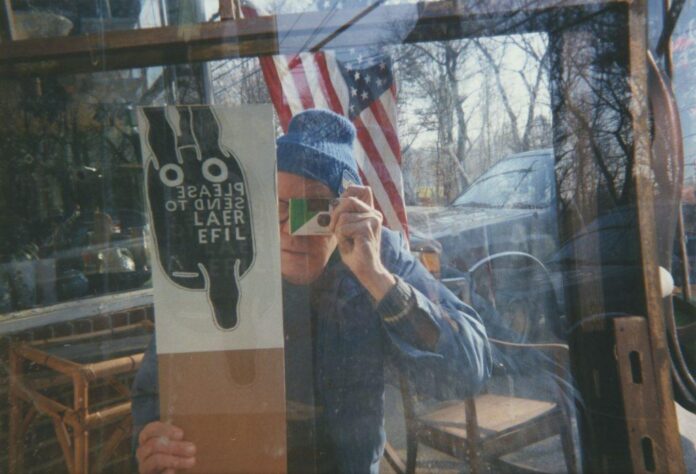We have finally received Ray Johnson’s dispatches from the other side. Last month, the Morgan Library & Museum opened “PLEASE SEND TO REAL LIFE,” an exhibition unearthing 200 never-before-seen photos by Johnson, the founder of the international mail art network know as the New York Correspondence School, who died in 1995.
After studying abstraction under Josef Albers at the famous Black Mountain College, Johnson left North Carolina for New York in 1948, along with professors John Cage, Merce Cunningham, and Richard Lippold.
Though he was set up for fame as a painter, he took Albers’s advice, according to the Morgan, and burned his early works between 1954 and 1956, to make room for the miniature mass media collages he called “moticos,” now hailed as precursors to Pop art.

Hazel Larsen Archer, (1948), gelatin silver print. The Morgan Library &Museum, Purchased as the gift of David Dechmanand Michel Mercure, 2021.56. © Estate of Hazel Larsen Archer.
Photography was always a cornerstone of Johnson’s practice, but it wasn’t until 1992—two decades after leaving Manhattan for Long Island—that he adopted a Fujifilm QuickSnap camera and told curator Clive Phillpot: “I’m pursuing my career as a photographer.” Johnson would go through 137 disposable cameras by December 1994.
Among his experiments with the popular medium, Johnson would snap works in photobooths, often bringing in his cutout collages in artistic cameos. Photography could also enrich existing works with new meaning, such as his “Movie Stars” series of large-scale collages on corrugated cardboard, which often featured famous faces. Outdoor Movie Show in RJ’s backyard (1 June 1993), for example, sees these works lined up as if ready to film a scene, surrounded by the semi-autobiographical bunny character that was Johnson’s calling card.

Ray Johnson’s (1960s). Courtesy of the Ray Johnson Estate. Digital image courtesy of The Morgan Library & Museum. Artwork courtesy the Ray Johnson Estate. © Ray Johnson / Artists Rights Society (ARS), New York.
In January 1995, Johnson killed himself by jumping off a bridge in Sag Harbor, drowning in the water below. “I think Ray will become famous after his death, because he won’t be around to impede the dissemination of his work,” remarked New York art dealer Richard Feigen in the obituary that followed.
Although he bristled against institutions trying to show his work, there’s been an uptick in exhibitions culled from Johnson’s estate in the decades that followed his death, including shows last year at the Art Institute of Chicago and David Zwirner. Both focused mostly on Johnson’s collages and situating him among colleagues like John Cale and Joseph Cornell.
More than 5,000 color photographs by Johnson have survived, many kept off view in envelopes. The Morgan show’s curator, Joel Smith, told Arnet News that Johnson’s estate donated the 200 on view now to the museum’s permanent collection in 2019, courtesy of art advisor Frances Beatty. Research on the works carried on through early 2020.

Elisabeth Novick, (1955), gelatin silver print, Courtesy of the Ray Johnson Estate.
“The pandemic caused changes in scheduling that pushed [the show] back to summer 2022,” Smith said. “In the interim, we learned more about the photographs, and also acquired the 1948 photograph of Johnson by Hazel Larsen Archer that became the earliest (and first) piece in the exhibition.”
Still, no one knows for sure what Johnson meant to do with all the film he shot. “It would be trivial to hunt through this large, complex, often comical, always personal body of work for nothing more than a rebus suicide note,” Smith’s essay in the show’s catalog notes. “Ray Johnson never made himself that easily readable.”
Immediate and intimate, Johnson’s work is about the present moment. Taking a prototype selfie in a shop window mirror, Johnson holds up a bunny-eared collage reading: “PLEASE SEND TO REAL LIFE.” Maybe he meant the former New York magazine . Smith hears Johnson saying: “Here, Life, take this thing I’ve made; I’m going to the other place.”
See more images from the exhibition here.

(spring 1992). The Morgan Library & Museum. Gift of the Ray Johnson Estate, courtesy of Frances Beatty. © Ray Johnson/Artists Rights Society (ARS), New York.

(autumn1992). The Morgan Library & Museum, Gift of the Ray Johnson Estate, courtesy of Frances Beatty. © Ray Johnson / Artists Rights Society (ARS), New York.

(February 1993). The Morgan Library & Museum, Gift of the RayJohnson Estate, courtesy of Frances Beatty. © Ray Johnson / Artists Rights Society (ARS),New York.(ARS), New York.

(July 1992). The Morgan Library & Museum, Gift of the Ray Johnson Estate, courtesy of Frances Beatty. © Ray Johnson/Artists Rights Society (ARS),New York.

(February 1993). The Morgan Library & Museum, Gift of the Ray Johnson Estate, courtesy of Frances Beatty. © Ray Johnson/Artists Rights Society (ARS), New York.

(17 April 1993). The Morgan Library & Museum, Gift of the Ray Johnson Estate, courtesy of Frances Beatty. © Ray Johnson/Artists Rights Society (ARS),New York.

(February 1994). The Morgan Library &Museum, Gift of the Ray Johnson Estate, courtesy of Frances Beatty. © Ray Johnson/Artists Rights Society (ARS), New York.

(spring 1992). The Morgan Library & Museum, Gift of the Ray Johnson Estate, courtesy of Frances Beatty. © Ray Johnson/Artists Rights Society (ARS),New York.

(31 March 1993). The Morgan Library & Museum, Gift of the Ray Johnson Estate, courtesy of Frances Beatty. © Ray Johnson/Artists Rights Society (ARS), New York.

(February 1993). The Morgan Library & Museum, Gift of the Ray Johnson Estate, courtesy of Frances Beatty. © Ray Johnson/Artists Rights Society (ARS),New York.

























